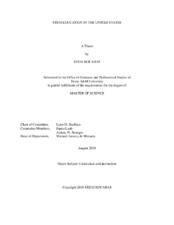| dc.description.abstract | STEM education is described as a systematic teaching and/or learning process in the STEM fields and a positive correlation exists between STEM education and the economic prosperity and power of a nation in the globalized world. In recent years, rising concerns have emerged about American STEM education. Many stakeholders wonder that whether the nation has enough well-qualified STEM students, teachers and workforce to maintain its current competitive edge. They are also curious about whether federally funded STEM education programs are sufficient and work effectively. This study seeks to answer those questions, presenting a unique view about the concerns.
American students in elementary and secondary schools have relatively mediocre scores compared with their international peers (especially Asians), although they perform better than earlier American cohorts. The quality of STEM teachers also leads to concerns. The lowest certification rate of teachers is found in science and mathematics, and approximately half of the teachers do not have a degree in the subject that they teach. Furthermore, higher education is more significant for STEM workforce.
Concern is growing that China is gaining a competitive edge against the United States in its STEM workforce. China now has about the same graduation rate as the United States in Science and Engineering (S&E) fields.
All these concerns raise concerns about the role of the federal government in STEM education. Over time, the government has created and funded a variety of STEM education programs. In recent years, has become more focused on the coordination and administration of these programs to improve effectiveness and efficiency. Several reports have been published that have analyzed the programs and provided information about duplications, overlaps, and the participation
rates of underrepresented population, among others. In consideration of the findings of these studies, the government has created policies to improve STEM education by using resources more effectively. Whether these will stem the tide is unknown.
However, hope exists. Although American STEM education does not create enough well-trained graduates and the Chinese graduation rate in the S&E fields has dramatically increased, the United States one key advantage. Even if China has a larger STEM workforce than the United States, the United States likely will maintain its superpower because the American workforce comprises a wide variety of people. This diversity quite likely brings with it more innovative ideas and research, which has made (and will keep) America great. | en |


